ISE PENINSULA
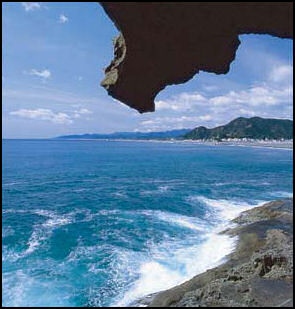
Ise coast ISE PENINSULA contains some of the most beautiful coastline in Japan. Among the beautiful inlets and islands are numerous wooden rafts where pearl farmers grow cultured pearls. Inland are mountains and some of Japan's most famous temples. The Peninsula is also called Shima-hanto Peninsula and the Ise-Shima region.
Mie Prefecture covers 5,774.4square kilometers (2,229 square miles), is home to about 1.8 million people and has a population density of 314 people per square kilometer. Tsu is the capital and largest city, with about 280,000 people. It is in the Kansai area near Osaka and Kyoto on the central part of Honshu island. And has seven districts and 29 municipalities.
Ise-Shima National Park (about an hour from Nagoya, Osaka and Kyoto) is known for it pearl fisheries and magnificent seascape. Inside the park are two of Japan's most interesting sights: Ise Grand Shrine, and the most venerated of all Shinto shrines; and Wedded Rocks. The designation of national park is little misleading. The region is just as developed and populated as other rural areas of Japan. Website: Government National Park Site National Parks of Japan ; Photos japan-photo ; Getting There: Ise-Shima, equidistant between Tokyo and Osaka, is less than two hours from Chubu Centrair International Airport Nagoya.
Ise City
Ise (about an hour, hour and half by train from Osaka and Kyoto) is a city located on the eastern tip of Kii Peninsula. Formerly called Ujiyamada, it faces Ise Bay and is home to Ise Grand Shrine, the most sacred Shintō shrine in Japan, and is thus a very popular destination for tourists. The city has a long-standing title that roughly means "the Holy City", and literally translates to "the Capital of the Kami". Most of the city is within the geographic limits of Ise-Shima National Park. It has a population of about 130,000 people.
From Ise-shi Station, it's only a short walk to one of the many shrine halls that make up the most famous and revered shrine in all of Japan, Isejingu Shrine. Geku (outer shrine) is mystical in the early morning mist, standing quietly among the age-old trees of the surrounding deep green forest. As pilgrims have done for centuries, you head down to Naiku (inner shrine) through Oharai-machi.
You can wander through the old streets taking a rest at one of the many traditional tea shops that line the narrow streets before choosing a local souvenir from the tiny shops selling wooden toys and simple lacquer ware. Stroll into the Okage-yokocho area and you stumble back over 100 years. The area ambitiously replicated as a town from the Edo through Meiji Eras would be quite convincing were it not for the many tourists crowding the tiny shop fronts. Continue and cross the Ujibashi Bridge over the Isuzu River to enter the holy precincts of Naiku where you lose the crowds for a moment as you enter the deep forest before arriving at the main hall. On the way back to the station, stop off at one of the many restaurants offering the famous local cuisine of lobsters, oysters and delicious fresh fish from the Pacific. [Source: JNTO]
Tourist Information 14-6, Hommachi, Ise City, Mie Pref., Tel. 0596-23-3323, Hours: 8:30-5:00pm; ise-kanko.jp/english ;Ise City Tourist Information Center (Iseshi Station) Iseshi Station, 1-1-4 Fukiage, Ise City, Mie Pref., Tel. 0596-65-6091. Hours: 9:00am-6:30pm Websites: Ise town Website: ise-kanko.jp; Ryokan and Minshuku Japanese Guest Houses Japanese Guest Houses Budget Accommodation: Japan Youth Hostels Japan Youth Hostels Check Lonely Planet books Getting There: Ise is accessible by train from Nagoya and Osaka and other Japanese cities. Lonely Planet Lonely Planet ;Ise Jingu isejingu.or.jp
Sights and Towns in Ise Area
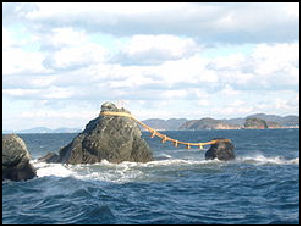
Wedded Rocks From Ise you can continue by the Kintetsu line on to Toba, the home of cultured pearls. Head straight to Mikimoto Pearl Island in time for the entertaining diving demonstrations by the women pearl divers of Toba, then stroll around the museum taking in the history and culture of this sparkling region. From here, it's a short walk to the huge Toba Aquarium where you are dazzled by the countless fishes and animals of all colors and sizes. A few minutes from Kashikojima Station you arrive at the boarding point for the magical 'España Cruise.' 'Esperansa', designed like a 16th-century Spanish sailing ship, takes you on a delightful 50-minute cruise around the windswept islands of Ago Bay, stopping at the Shinju (pearl) Model Factory. (Note: The 4:30pm departure doesn't stop at the factory. Service only available between March 21 and October 31.)
After your relaxing cruise, take a short stroll around the peaceful Maruyama Park and a break from all things maritime, before visiting Shima Marineland where all kinds of creatures in huge tanks surround you. You feel you are deep under the ocean, alone in another world as you pass along the dimly lit route. From Shimayokoyama Station, hiking up Yokoyama through blooming azaleas to the observation platform is also an option. From here you get a different angle on Ago Bay, one of waves crashing against stunning coastline, the deep blue ocean stretching out to the horizon 203 meters below. On your way back to Kashikojima Station, cross the Kashikojima Bridge for a stunning night view across the bay.
Wedded Rocks (20 minute walk from JR Futaimigaura station) is a pair of jagged rocks, rising from the sea near the coast, that are linked together by a giant Shinto rope. Nearby, Futami Sea park features shows with marine mammals and allows visitors to touch the animals when the shows are over. Website: Japan Guide japan-guide.com
Toba (7 miles from Ise) is the main tourist center in the Ise-Shima region. Among the cheesy attractions in the area are Toba Aquarium, and the Toba International Erotic Science Museum, which depicts naked human beings abducted by aliens with men having their sperm mechanically extracted and placed in beautiful women.
Websites: Ryokan and Minshuku Japanese Guest Houses Japanese Guest Houses Budget Accommodation: Japan Youth Hostels
Japan Youth Hostels ; Check Lonely Planet books Getting There: Lonely Planet Lonely Planet
Parque Espana (near Toba and Shima Isobe in the Shima) is a Spain-inspired. theme park, a cheesy place with less than thrilling rides and dull shows. Opened in 1994, the park welcomes about 1.5 million visitors a year with copies of the statues of Don Quixote and Sancho Panza found in Madrid’s Plaza de Espana. There are also replicas of the Plaza Mayor in Madrid, Las Ramblas in Barcelona, Santa Cruz Town in Seville and Javier Castle.
Among the Cervantes-themed rides are Don Quxiote’s Magical Flight. “Pyrenees” is billed as the longest suspension rollercoaster in Japan. Matador, a bullfight-inspired roller coater, places the rider in the position of the bull. The park’s mascots include Don Quixote hound, Pancho Panza bear and a white cat Dulcinea. Website: Japan Visitor blog japanvisitor.blogspot.com
Ago Bay (south of Pearl Island) is the center of Japan's pearl trade. The bay is filled with ladder-like frames supporting bamboo baskets of pearl-producing akoya oysters. Workers skillfully walk across the frames to check on the mollusks’ progress. Women divers work but their main job is collecting seaweed and shellfish not gathering pearls. Goza is a fishing village that is worth visiting.
Yokkaichi Factory Cruise
Factory Tours are offered of the sprawling industrial zones of Yokkaichi, Mie Prefecture. Yokkaichi once appeared in textbooks as an example of a polluted environment in Japan. There is a huge area of chemical plants in Yokkaichi. At Yokkaichi’s Shiohama petrochemical complex there are big towers standing side-by-side give and massive silver spherical gas tanks. The towers and plants are illuminated by yellowish spotlights at night. A spokesperson of the city’s tourism association said, “We want many people to see from the boat how the city is changing.”
According to unmissablejapan: Yokkaichi “achieved fame as possibly the most polluted place in Japan, but thankfully its heavy industries have cleaned themselves up, so the air is now safe to breathe. This is a good thing, as Yokkaichi is home to a really huge industrial complex packed with large factories that put on an excellent display every evening. The factories are lined up along the waterfront, and so are best viewed from one of the Yokkaichi Industrial Complex Night View Cruises that take place on Fridays and Saturdays, and occasionally on other days during peak periods. (Check here for times and dates of forthcoming cruises.) [Source: unmissablejapan]
A one-hour cruise costs ¥3,500, and departs at 5:00pm in winter, or 7:00pm the rest of the year. In July and August, there is a second cruise at 8:15pm. You can either meet at the Yokkaichi Harbour Futo Building (marked with A on this map here) where free parking is available, or you can arrange to be picked up from either Kintetsu Yokkaichi Station or JR Yokkaichi Station. Phone enquiries can be made to the Yokkaichi Tourism Association on 059-357-0381, or by email to kanko@kanko-yokkaichi.com. Bookings are accepted by email, or by fax on 059-355-8311. To get to Yokkaichi, take the Kintetsu-Nagoya Line from Nagoya Station to Kintetsu-Yokkaichi Station (33 minutes, ¥610) . Nagoya Station is on the Tokaido Shinkansen that connects Tokyo and Osaka.
Ama, Female Divers
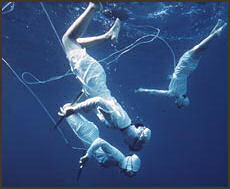
Ama are women divers who collect various kinds of sea food in coastal waters from the ocean floor. They dive up to 60 feet, up to 75 times a day. Women are chosen for this job because they have more body fat to insulate them in the cold water than men.
The Ama specialize in gathering abalone. They also collect “sazae” (wreath shells), lobster and “tengusa” seaweed. For years they were employed by the cultured pearl industry to collect oysters from natural beds around Japan. But these days they are no longer needed for that because most pearls today are cultured pearls that come from farmed oysters.
In the old days Ama often dove topless or wore traditional white cotton diving togs. They collected abalone for the Emperor’s enthronement ceremony and were depicted in many Edo-period woodblock prints with bare breasts and combs in their hair. After World War II, many worked at night as entertainers and ama-geisha. In the James Bond film “You Only Live Twice”, ama help disguise 007.
Young ama used to go through a kind of initiations. To prove their strength they had to make deep dives and stay underwater until their lungs were bursting. Once they made the grade they were allowed to attend special festivals held in secret locations in which they swam and danced in the nude and wore long-nose Tengu masks.
The ama work in small teams and dive at their favorite diving spots just in sight of the shore from boats driven by their husbands, They usually stay underwater for less than a minute but sped four or five hours a day in the water. The ama wear wetsuits and masks. They use hooks, hammers and crowbars to pry abalone loose and carry plastic abalone measures and small water tight drums. They spread white cream on their faces to protect them from the salt and sun and wear special goggles installed special apparatuses that keeps their eyes from popping out of their sockets due to the pressure. Skilled ama can earn as much as $100,000 in 70 days of diving. When they are not working in sea, ama sometimes work in hills growing flowers and vegetables.
Ama Hut Hachiman (in IseShima) give you a close-up look at the ama (“women of the sea”) way of life. Try on elegant ama diving garb, join the divers in a traditional dance and feast on freshly caught seafood (vegetarians also catered for) . Their warm hospitality and tales of the sea will move each and every listener. Location: 819 Osatsu-cho, Toba-shi, Mie Website: /amakoya.com
Mikimoto Pearl Island
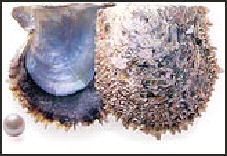
pearl oyster Mikimoto Pearl Island (near Toba) is where the world's first cultured pearls were raised by Kokichi Mikimoto in the early 20th century. Visitors can observe the production process — including the seeding, selection, drilling and stringing of the pearls — and enjoy a demonstration of “ama” (women divers) gathering pearl oysters and see trays full of pink, gold, blue and black pearls worth hundreds of thousands of dollars. Some of the demonstrations are in English.
In 1932 Mikimoto purchased the island and converted it into Pearl Island. In earlier times the island was as playground by a local daimyo. The island is reached by a footbridge that is covered by trees and greenery. The buildings are understated. Over the years the island has attracted millions of visitors.
Visitors can shop for pearl products, and tour the pearl museum, with an interesting display on how culture pearls are made and an interesting collection of curiosities, including pearl tiaras favored by royal families around the world. The Mikimoto collections contains of reproduction of the Liberty Bell made in 1939 with blue pearls defining the famous crack and the fire-tiered Gojunoo pagoda carved from mother of pearl and set on background of pearls. Most impressive is the Yagurama broach made with pearls, diamonds, emeralds and sapphires that can be changed into 12 different pieces of jewelry. In Kokichi Mikimoto Memorial Hall you can see displays on the Mikimoto’s life and personal items that belonged to him. Website: Mikimoto Pearl Museum mikimoto-pearl-museum.co.jp ; Mikimoto Pearl Island karipearls.com ; Japan Guide japan-guide.com
Pearls
Pearls are produced by oysters as everyone knows. They are composed of 90 percent argonite calcium carbonate, a substance applied to a nucleus of pearl by the same organ (the mantle) of the oyster that creates the shell, and 10 percent conchiolin, a gluelike protein that binds together the calcium carbonate crystals. Fossil pearls are abundant in 60 million-year-old rocks. [Source: Fred Ward, National Geographic, August 1985 ┦; David Doubilet, National Geographic, December 1991; Nigel Sitwell, Smithsonian]
Calcium carbonate is the material from which cement and limestone are made and argon is an inert gas like neon. This nacre is applied in layers about a thousandth of an inch thick. The growth pattern makes cultured and natural pearls feel rough when rubbed on the teeth. One advantage pearls have over gem stones and gold is that didn't require any cutting or smelting. They came straight from the shell ready to go. This was especially important to ancient people didn't the have the technology we have today to cut stone and produce metal.
Pearls come in a wide variety of colors and shades — silver, cream, old, green, blue and black — and seem to glow from within because light penetrates the surface and reflects off the inner layers. They respond differently to different kinds of light and enhance the color of a woman's skin Many people prefer pearls to diamonds because they believe they compliment a woman’s beauty rather than upstage it. One gem buyer with Van Cleef & Areples told Smithsonian, "In the jewelry business, pearls are considered the most feminine of gems. I don't know a woman who doesn't lie pearls."
See Separate Article PEARLS: HISTORY, MARKETS, PRODUCTION AND MIKIMOTO CULTURED PEARLS factsanddetails.com
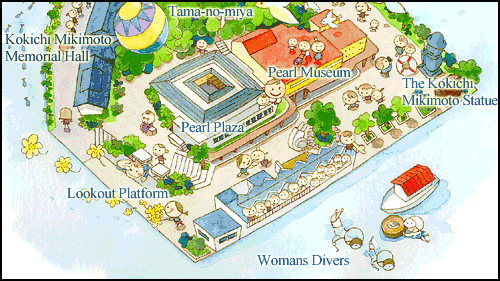
Pearl Island
Image Sources: Japan National Parks, Ise jingu site, Wikipedia, Mikimoto Pearl Museum
Text Sources: JNTO (Japan National Tourist Organization), Japan.org, Japan News, Japan Times, Yomiuri Shimbun, Japan Ministry of the Environment, UNESCO, Japan Guide website, Lonely Planet guides, New York Times, Washington Post, Los Angeles Times, National Geographic, The New Yorker, Bloomberg, Reuters, Associated Press, AFP, Compton's Encyclopedia and various books and other publications.
Updated in July 2020
